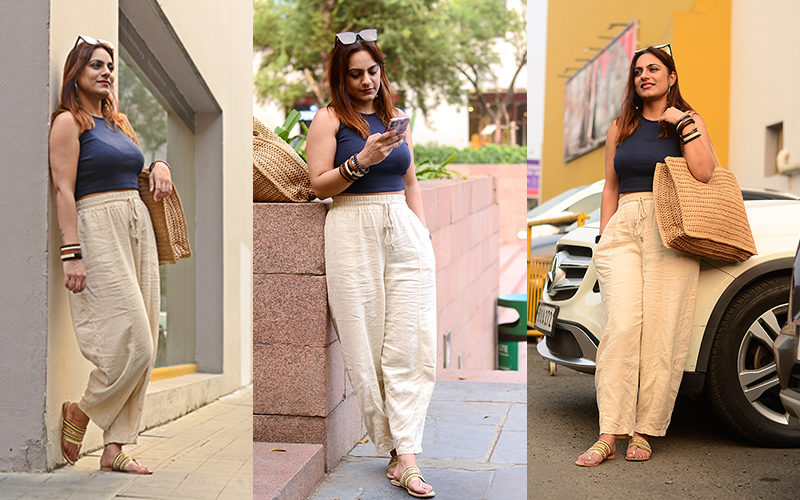 Capsule Wardrobe
Capsule Wardrobe
When less is more: Capsule wardrobes drive sustainable fashion in the US and India
When University of Georgia student Kyndal Coleman moved into her college apartment, she discovered she’d have to make do with a small closet. So she pared down her wardrobe to keep just a few versatile essentials.
Aarati Bhandare, who lives 9,000 miles away in Karnataka, India, has always kept a small wardrobe. Whenever she gets a new piece of clothing, she gives away two old ones. It's one of many ways she lives out her commitment to a sustainable environment.
The two women are participating in a global fashion trend that’s taking off in the East and West: the capsule wardrobe, a minimal collection of interchangeable clothes that can create many outfits. It's a newly popular form of sustainable fashion that relies not just on environmentally friendly fabrics or production methods but on buying less.
Fashion experts acknowledge capsule wardrobes can limit personal expression for consumers and potentially reduce profits for clothing retailers. But they point to many groups that could benefit: People with small closets -- or budgets. Frequent travelers who don't want to check a lot of luggage. Or business professionals now working remotely who no longer need so many office clothes.
"Two or three T-shirts, one pair of jeans, one skirt, one dress — that can set you up for success because you can easily mix and match those items to create at least four outfits for the week," said Atlanta-based stylist Melissa Young.
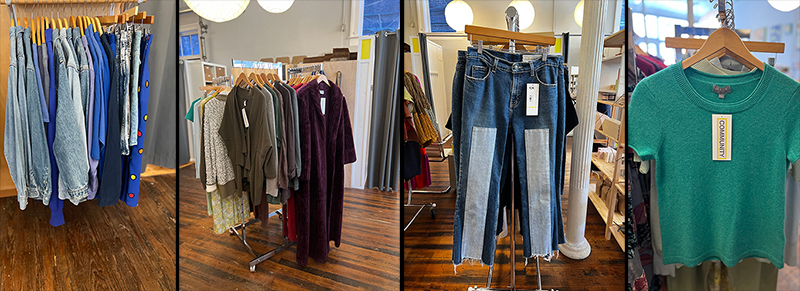 A rack sustainably sourced denim trousers in Community, a retailer in downtown Athens that helps other local businesses by selling their items in store. (Photo/Asya McDonald)
A rack sustainably sourced denim trousers in Community, a retailer in downtown Athens that helps other local businesses by selling their items in store. (Photo/Asya McDonald)
Stylists and those who use capsule wardrobes say one of the biggest advantages is that dressing this way helps care for the environment during a climate crisis in which every action matters.
According to the United Nations, the $2.5 trillion dollar apparel industry is the second-highest user of water globally, producing 20% of global water waste. And 85% of textiles are sent to landfills, equal to 21 billion tons a year. This often happens with fast fashion which is mass produced at low cost, allowing people to buy lots of things they end up throwing away.
Combatting fashion waste, with sustainable wardrobes and other solutions, was a big focus at Atlanta Sustainable Fashion Week in October, which brought together vendors and officials from Canada, Italy and the Netherlands.
“This is a global movement,” event founder Tanjuria Willis said. “It's not just specific to Atlanta, it's global. And we can't make change unless we all make changes together.”
CURATING A CAPSULE
Sha’mira Covington, assistant professor in fashion at the University of Georgia, said she first saw the term “capsule wardrobe” in the early 2010s in a book about minimalist fashions and closets. But among the general public, the idea has taken off much more recently.
While anyone can shift their closet into a capsule wardrobe, Young said the lifestyle is particularly well suited for business professionals looking for interchangeable work clothes on a budget — or, really, anyone who wears a consistent style.
Some make the choice at least in part to save space. Erika Messerschmidt, a curator at Rent the Runway in Manhattan, keeps a capsule wardrobe of work clothes and basic jeans and shirts in her small New York City apartment. She rents designer clothing for special occasions.
Others are trying to save money. Bhandare – who directs the Amulya Boondh Foundation, a nonprofit organization emphasizing sustainable living – said her first capsule wardrobe came as a necessity and not a choice. She grew up in a lower middle-class family and said her parents “chose to spend (their) money on eating healthy, teaching us various kinds of sports, maintaining physical health, learning languages, rather than buying new clothes every day.”
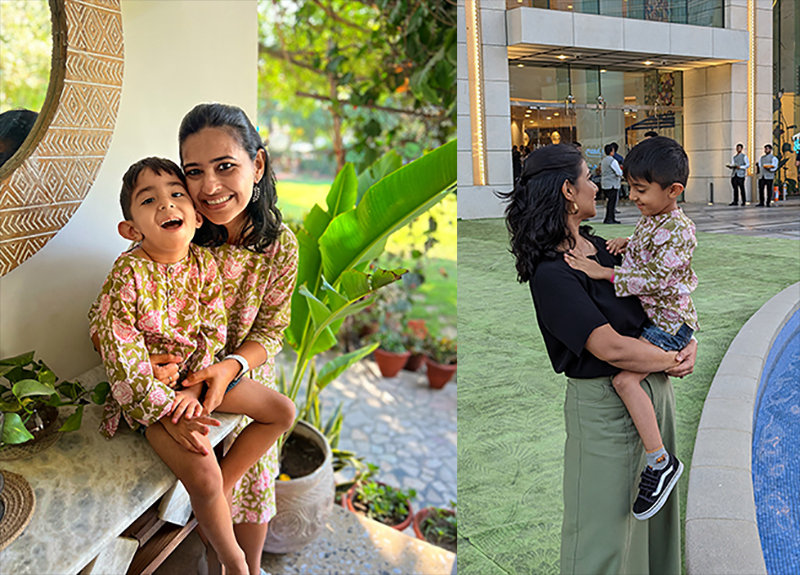 Sonika Bhasin, a sustainable lifestyle and parenting blogger, proudly wears hand-me-down pants to avoid buying new clothes. Sonika and her son only wear sustainable brands. (Photo/Khushi Malhotra)
Sonika Bhasin, a sustainable lifestyle and parenting blogger, proudly wears hand-me-down pants to avoid buying new clothes. Sonika and her son only wear sustainable brands. (Photo/Khushi Malhotra)
But capsule wardrobes aren’t always budget-friendly. While they can be built with thrift store finds and other inexpensive items, they can also include more expensive clothing that’s hand woven or made of high-quality, sustainable material, said Sonika Bhasin, a sustainable lifestyle and parenting blogger in India with over 60,000 Instagram followers. Still, she said, if consumers buy a small number of long-lasting clothing items, they can avoid spending too much.
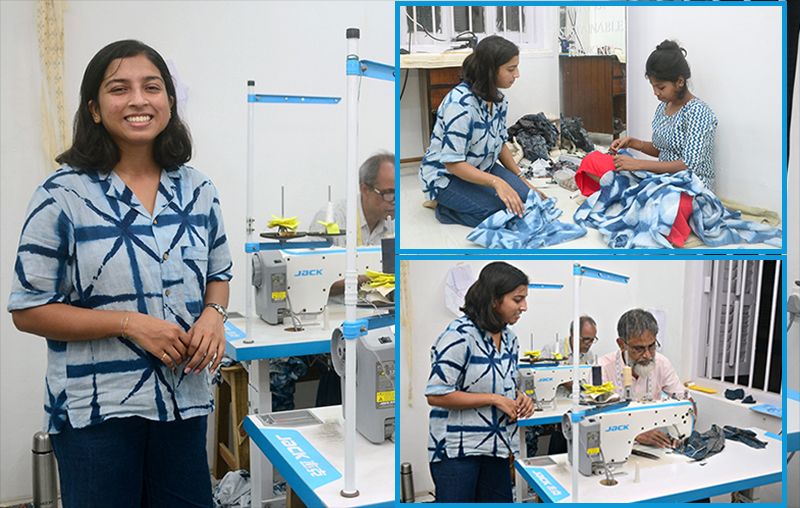 Kolkata-based textile designer Matrika Bhandari after completing her graduation from National Institute of Fashion Technology (NIFT) Delhi pursued post-grad at the Royal College of Arts London before she co-founded Inkriti. (Photo/Avishek Mitra)
Kolkata-based textile designer Matrika Bhandari after completing her graduation from National Institute of Fashion Technology (NIFT) Delhi pursued post-grad at the Royal College of Arts London before she co-founded Inkriti. (Photo/Avishek Mitra)
Whatever pieces they contain, the idea of “squeezing maximum utilization” out of a clothing collection is common in India, so the capsule notion fits right in, said Matrika Bhandari, co-founder of Inkriti, a sustainable, gender-neutral fashion brand working with both garments and handicrafts to make Indian textile crafts accessible. She said the ideal pieces for a capsule are “versatile,” like a black T-shirt, or “evergreen,” like a favorite sweater or saree. Other clothes can be donated or recycled. “You can mix-and-match — again something that Indians are brilliant at doing.”
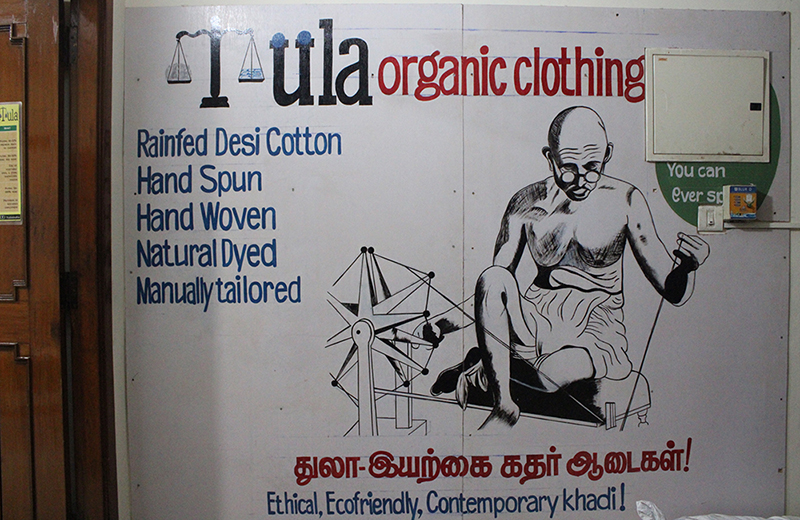 Tula Organic Clothing, a brand by a non-profit based in India’s Chennai, produces hand-spun clothes by rain-fed smallholder farmers. (Photo/Khushi Malhotra)
Tula Organic Clothing, a brand by a non-profit based in India’s Chennai, produces hand-spun clothes by rain-fed smallholder farmers. (Photo/Khushi Malhotra)
And a pared-down wardrobe doesn’t have to cramp personal style. Vidhi Adhikari, a sustainability influencer with 24,000 Instagram followers, for example, has a capsule made up of denim items, timeless black dresses and versatile shirts for a more Western versus traditional Eastern look.
Janhavi Poola of Tula Organic Clothing, a nonprofit social enterprise in Chennai producing handloom-spun, naturally-dyed garments, said whatever their style, people should buy clothes only if they need them because producing even eco-friendly garments consumes a lot of energy.
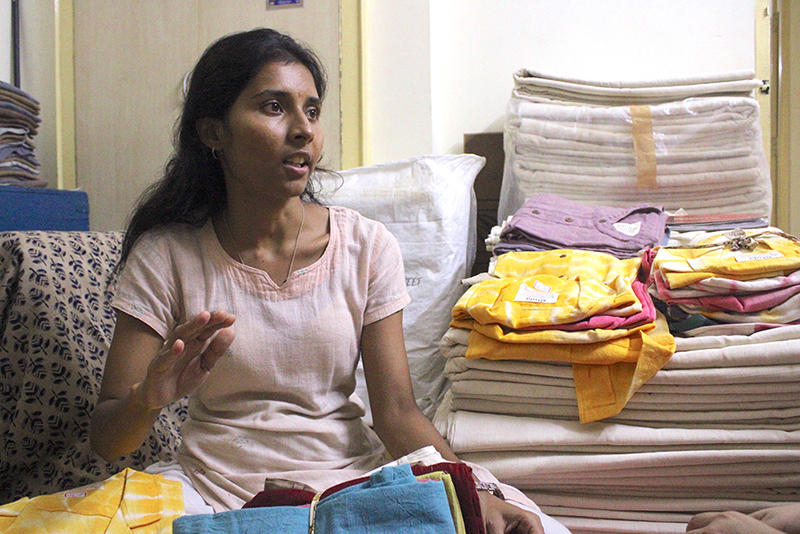 Tula’s team member Jahnavi encourages people to go ‘Kora’ (unbleached off-white) and embrace the natural color of cotton. (Photo/Khushi Malhotra)
Tula’s team member Jahnavi encourages people to go ‘Kora’ (unbleached off-white) and embrace the natural color of cotton. (Photo/Khushi Malhotra)
"If you ask me then 3-4 pairs of clothes would be good enough for your capsule wardrobe and the best thing to buy is chemical free products," Poola said. "Less is more, less is enough.”
MAKING IT WORK
Still, for some, limited wardrobes have a few downsides – although people have found ways around them.
When Atlanta-based fashion designer Alea Riley launched her sustainable fashion brand ALEIMAN, she said she quickly realized that “women want options” and “sticking to a specific thing is difficult.” Some clients missed the variety of mixing and matching more apparel pieces.
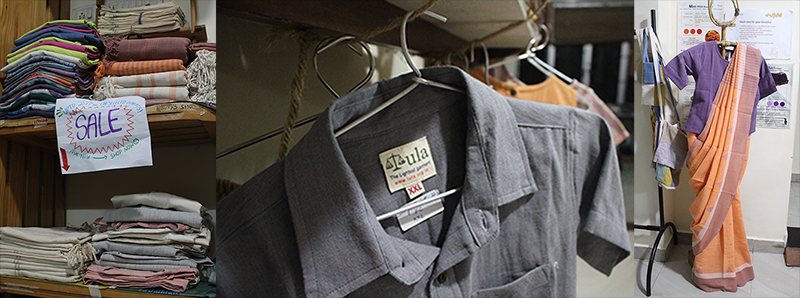 Quality over quantity: Tula Organic Clothing, based in India’s Chennai, urges people to buy clothes that stand the test of time and provide fair compensation for farmers. (Photo/Khushi Malhotra)
Quality over quantity: Tula Organic Clothing, based in India’s Chennai, urges people to buy clothes that stand the test of time and provide fair compensation for farmers. (Photo/Khushi Malhotra)
So she came up with a unique solution: “I started to look at being able to wear things backwards, being able to wear things inside out, so that you truly have a different look,” Riley said. “That kind of extends the life of your wardrobe.”
Other people solve the problem of repetitive outfits by expressing themselves through accessories like jewelry, scarves, or ties, or accent pieces.
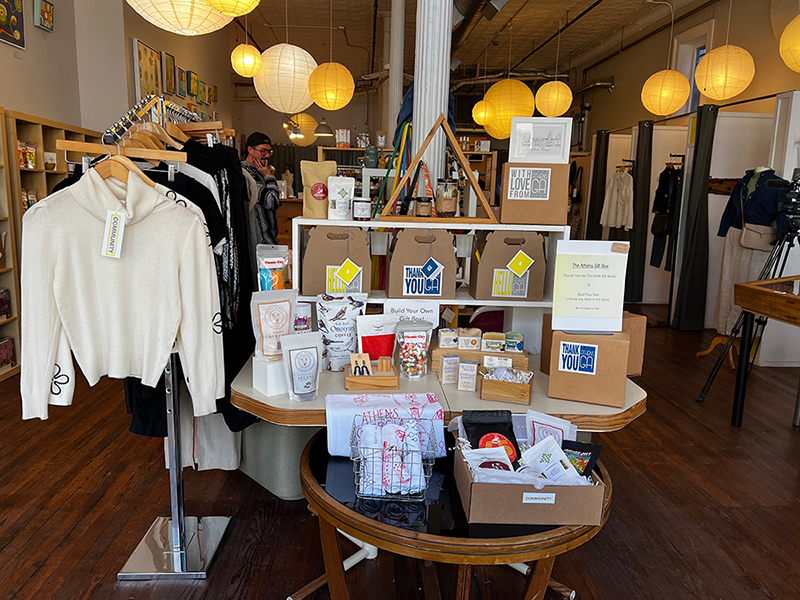 A photo inside Community, a retailer in downtown Athens that helps other local businesses by selling their items in store. (Photo/Asya McDonald)
A photo inside Community, a retailer in downtown Athens that helps other local businesses by selling their items in store. (Photo/Asya McDonald)
Patrizia Casubolo, CEO of Canadian clothing accessory company COCHIC, said some millennials wear her company’s colorful collar extenders – “like a red one, just to spice up the look.”
“You have just one simple dress shirt, right,” Casubolo said. “But you can spice up very, very well with an accessory.”
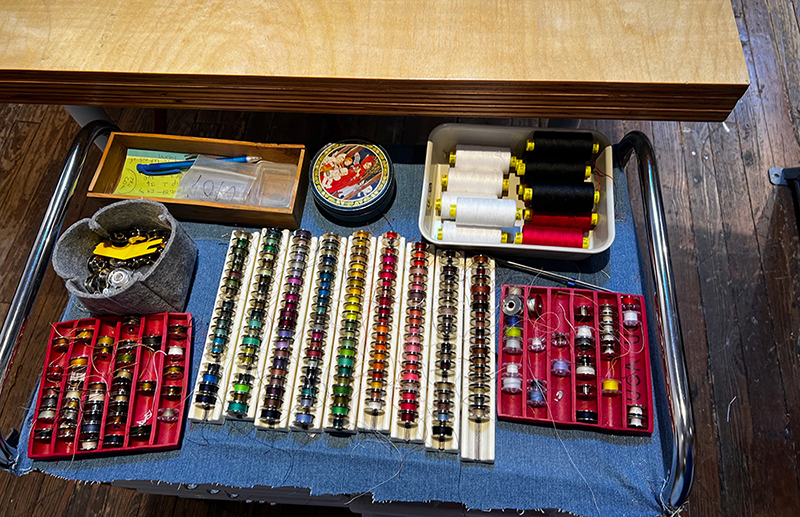 Sewing material from the sewing workshop in Community where they host sewing classes. (Photo/Asya McDonald)
Sewing material from the sewing workshop in Community where they host sewing classes. (Photo/Asya McDonald)
This way, one outfit can have many lives.
Coleman, the University of Georgia student, recently pulled her favorite little black dress out of her closet and held it against her body, smiling as she looked down at the backless, halter plunge neckline mini-length dress.
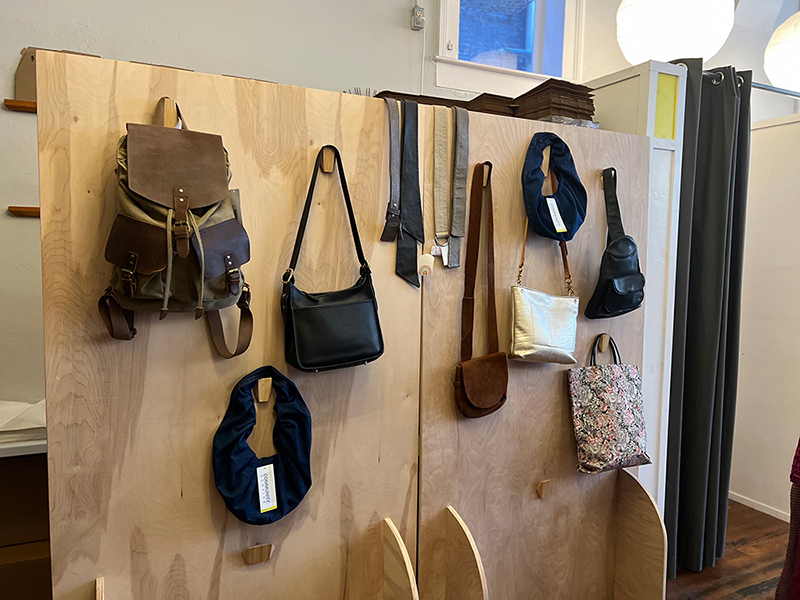 Accessories being sold in Community.(Photo/Asya McDonald)
Accessories being sold in Community.(Photo/Asya McDonald)
“This is my favorite thing to wear because you can just put anything on top of it, ” said the fourth-year environmental economics management major. “I’ve worn it to class, I’ve worn it downtown. I wore it with my Halloween costume when I dressed up as a pirate. I wear that dress for anything and everything.”
GOOD FOR BUSINESS?
The idea of buying less might seem appealing to customers looking to save space, time, money and the planet. But some clothing merchants hear “buy less” as “sell less.”
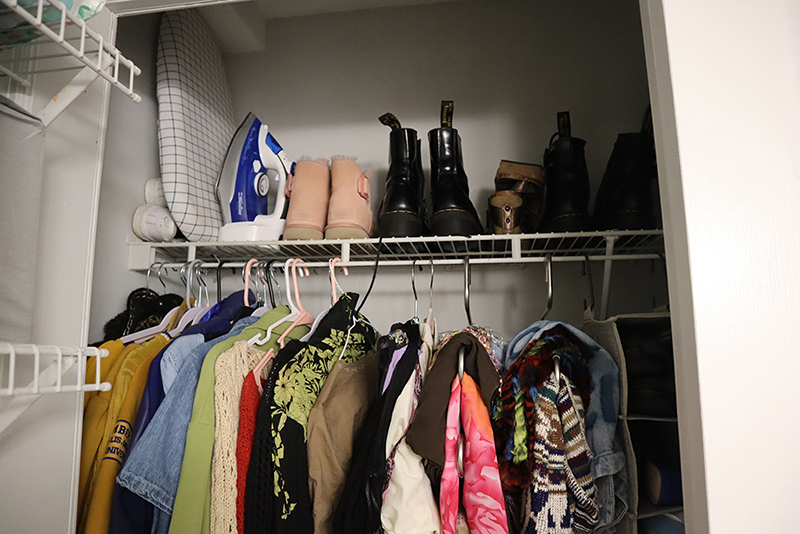 A close up picture of the left side of Kydnal Coleman's closet (Photo/Asya McDonald)
A close up picture of the left side of Kydnal Coleman's closet (Photo/Asya McDonald)
Community, a sustainable boutique in Athens, sells clothing and artisan products from over 50 Georgia-based makers. Its slogan is: “Supplies are limited.” While the store mends and alters old clothing, it hasn’t necessarily been marketing the concept of a capsule wardrobe, said Community’s manager J Hoover.
“Part of that might be that we are a retailer, so we do want people to come in and shop and shop often,” Hoover said.
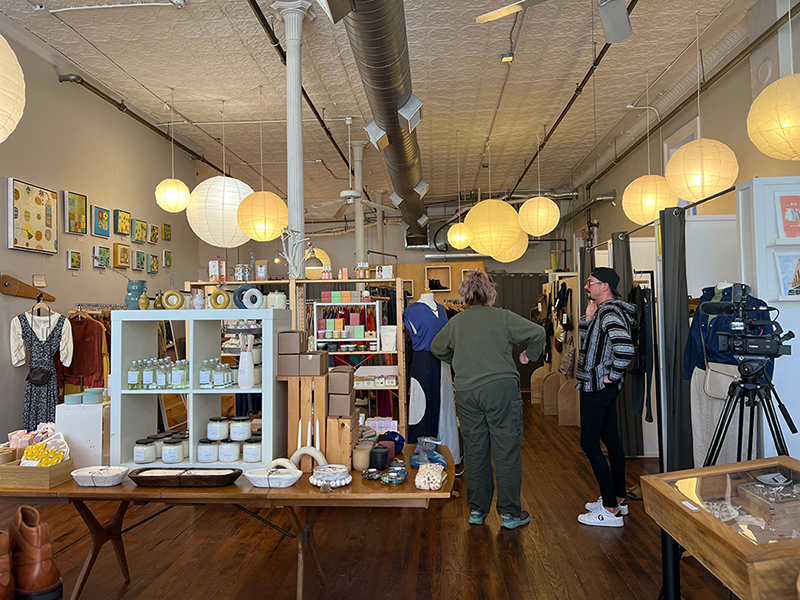 J Hoover helps a customer in Community as they look for sustainable clothing for a present to give to a family member. (Photo/Asya McDonald)
J Hoover helps a customer in Community as they look for sustainable clothing for a present to give to a family member. (Photo/Asya McDonald)
With fast fashion, meanwhile, consumers often wind up buying a lot simply because the clothing doesn’t hold up, with retailers reaping the profits.
But some industry observers sense an equally strong move away from rampant consumerism by many people and expect the capsule wardrobe concept to keep gaining ground on both sides of the world.
Richi Sakhuja, a public relations professional for 14 years, said sustainable clothing and pared-down wardrobes have always been part of Indian culture even before the concepts had names.
As she walked through an open-air shopping mall in Kolkata sporting a blue sleeveless top and beige cotton pants, she said what’s changed recently is sustainability has become the “it word.” And that means supporting ideas like capsule wardrobes can potentially improve a company’s image and sales, she said, since it’s part of a larger emphasis on environmental and social issues.
Nathan Stuck, who teaches in the University of Georgia’s MBA program, said the same is true in the U.S. He helps companies get certified as B Corps — a designation that a business is meeting high ethical standards, including environmentalism.
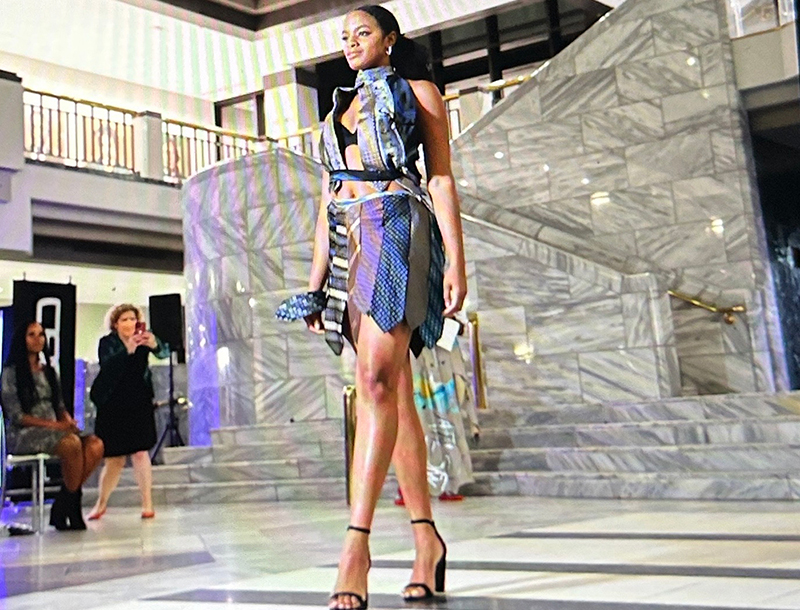 Students like Tyra Robinson from Charles R. Drew Charter School in Atlanta, worked with the National Black Arts Festival to learn about sustainable fashion and showcase their designs at Atlanta Sustainable Fashion Week’s opening night on Wednesday, Oct. 11, 2023. (Photo/Cassidy Hettesheimer)
Students like Tyra Robinson from Charles R. Drew Charter School in Atlanta, worked with the National Black Arts Festival to learn about sustainable fashion and showcase their designs at Atlanta Sustainable Fashion Week’s opening night on Wednesday, Oct. 11, 2023. (Photo/Cassidy Hettesheimer)
“I like to say good business is good for business,” he said.“That (designation) is what Gen Z wants. It's what millennials want.”
Experts say they only expect environmental awareness to grow. And that – along with the ever-present desire to save space, time and money – will likely push more people to try capsule wardrobes or stick with them.
Coleman, for one, remains committed to the concept. If she were to transition her closet from home to college all over again, she said she’d bring less. “If I had to bring something, I’d probably just bring my favorite jeans and a few tank tops and see what I can do from there.”
(As part of a new program at the University of Georgia, students in the Cox Institute's Journalism Writing Lab worked with students from India on joint story projects that link their two countries. The project is overseen by Laura Ungar, a senior journalist with The Associated Press, and Sujoy Dhar, founder of the Indian news agency India Blooms News Service, as well as writing lab Director Lori Johnston.)
Support Our Journalism
We cannot do without you.. your contribution supports unbiased journalism
IBNS is not driven by any ism- not wokeism, not racism, not skewed secularism, not hyper right-wing or left liberal ideals, nor by any hardline religious beliefs or hyper nationalism. We want to serve you good old objective news, as they are. We do not judge or preach. We let people decide for themselves. We only try to present factual and well-sourced news.







